Ranked among the most rewarding activities, container gardening is now more popular than ever. While some Americans deem it therapeutic, others are enthralled by the art of nurturing different plants. There’s also another lot in this game to make a living, explaining why at least 55% of U.S. households garden.
Unfortunately, it’s so easy to get carried away by the amazing benefits of container gardening that you disregard the challenges involved, such as repotting. If done incorrectly, replanting can damage your plant’s roots and derail proper growth. That’s one of the reasons most growers prefer doing it annually to minimize their chances of making that blunder.
Which plants can thrive in pots throughout the year? This article discusses your six best plant options for year-round pots, giving you valuable details you should know before embarking on your gardening journey. Let’s get started!
1. Pieris japonica
Also known as the Japanese andromeda, the eye-catching Pieris japonica is an evergreen shrub from the heath family Ericaceae. One of the reasons it tops our list of the best plants for year-round pots is its low-maintenance. Pruning mainly happens in June, but the ideal time varies depending on location. If you’re in cooler areas, ensure the plant gets at least 6-8 hours of sunlight daily. But since Japanese andromeda also craves shade, remember to shield it from the harsh afternoon heat.
The Pieris japonica’s pale pink, red, and sometimes white blooms will fill your garden with unmatched beauty. We recommend planting it in the spring so it can establish quickly. However, if the opportunity passes and you still yearn to see it in your outdoor space, any other time of the year will do. Thankfully, these plants flourish in containers, especially with proper care.
Growing Pieris japonica in Pots
A 5-gallon container is perfect for planting the Pieris japonica alone. Even so, you’ll need a larger pot with a diameter of at least 18 inches if the shrub is part of a mixed display. The soil should be moist and well-drained, with considerable organic matter. Deep water the plant at least once a week to aid healthy growth.
If you’re yet to decide on the Pieris japonica cultivar to plant, consider these options:
- ‘Mountain Fire‘ – Known for its fiery orange-red foliage.
- ‘Pink Delight’ – Boasts pale pink, urn-shaped blossoms.
- ‘Valley Rose’ – A compact, multi-stemmed Pieris japonica with pink flowers that bloom in the spring.
- ‘Flaming Silver’ – Has bright red leaves that turn pink and eventually green with silver/white edges.
- ‘Dorothy Wyckoff’ – Compact and rounded, this Pieris japonica variety has soft pink buds that turn reddish-purple and white upon maturity.
Pieris japonica varieties have different sizes, flower colors, resilience, and bloom time. Make sure to consider these aspects before making your pick.
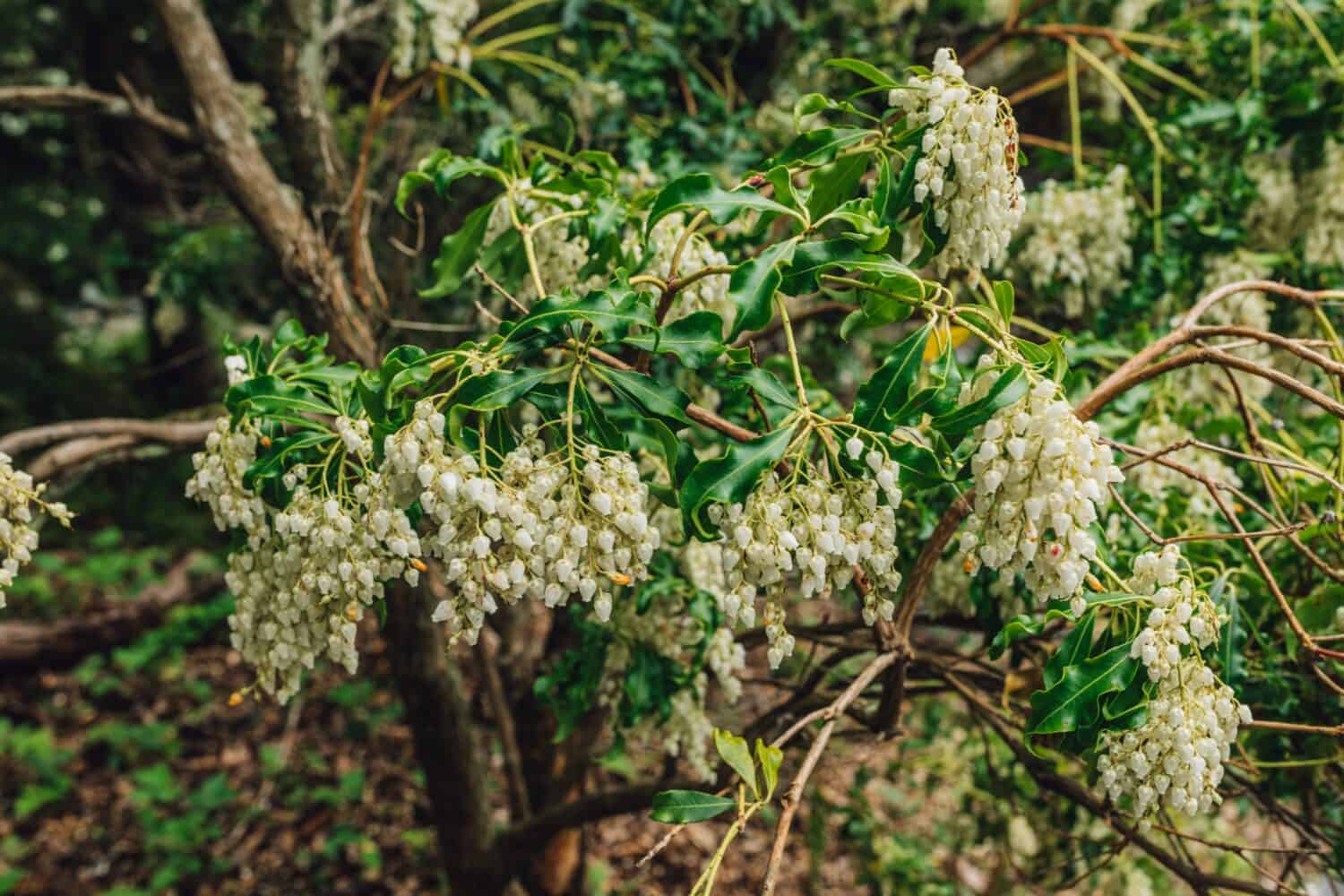
The
Pieris japonica’spale pink, red, and sometimes white blooms will fill your garden with unmatched beauty.
©Nicole Kandi/Shutterstock.com
2. Bonsai Trees
Bonsai trees are resilient plants that flourish in containers all year. Undeniably, these species are remarkable, with their different style variations and finely-branched crowns. You can grow them indoors and outdoors, but only in the right pot. As a rule of thumb, it should be the same height as the tree’s trunk above the soil level. Round containers must be at least 1/3 of the plant’s size. But rectangular or oval jars can be 2/3 of the latter.
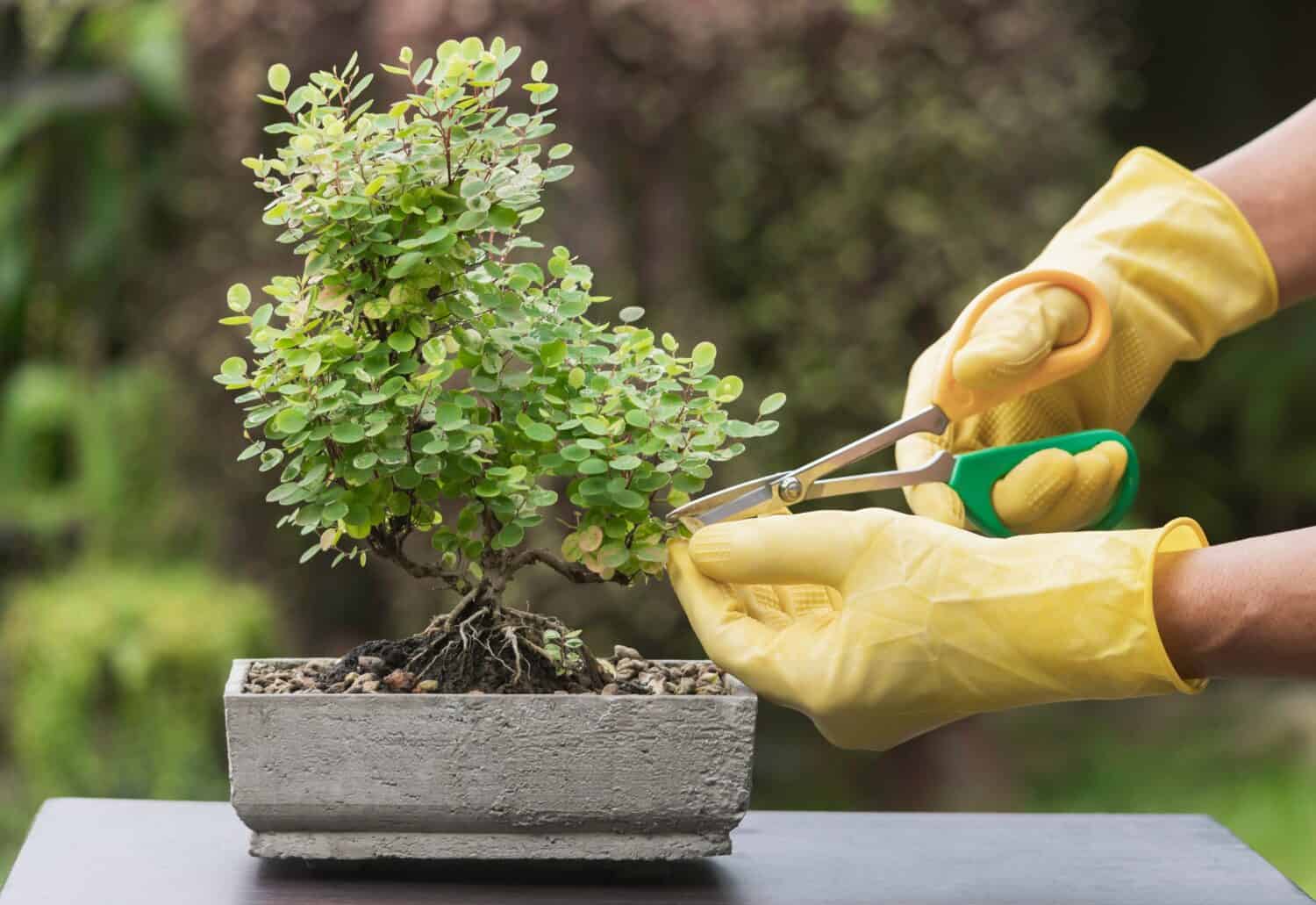
Caring for bonsai trees shapes your thoughts and soothes you, reducing your anxiety.
©MintraTH/Shutterstock.com
Although you should repot bonsai trees every 2-5 years, the plants are extremely demanding, unlike our top pick above. You must prune them 2-4 times annually to facilitate growth and help retain their desired shapes. They grow slowly and can take up to twelve years to fully mature.
On the upside, these miniature plants offer the following advantages to compensate for their high-maintenance nature:
They Improve Your Mental Well-Being
Growing bonsai trees in your outdoor garden provide a green zone to meditate and relax. Caring for them also shapes your thoughts and soothes you, reducing your anxiety. Additionally, these trees increase your focus to enhance your productivity and overall well-being.
Many Species are Available
Did you know there are more than twenty bonsai tree species? Undoubtedly, you’re spoilt for choice when hunting for options of bonsai plants to grow in year-round pots. These include juniper, maple, Chinese elm, pine, cedar, dwarf jade, pomegranate, azalea, and beech tree. Make your pick based on factors like the plant’s health and experience. For example, beginners should opt for easy-care species like ficus and money trees.
They Present Lucrative Business Opportunities
The global bonsai market is expected to hit $15847.7 million by 2027. If you enjoy growing these trees, you can potentially turn your passion into a highly profitable career. Do this by purchasing a few of these plants at a specific price and reselling them at a higher one.
Then again, you can get new bonsai trees and care for them until maturity. Although that might take more than ten years, the plants can bring in millions, which is good money in our books.
3. Hebe
Hebe plants boast delightful color palettes in spring, summer, and fall. Their flowers come in dazzling shades of white, mauve, and pink; their foliage can be green, silver, or purple. Some cultivars develop a reddish or lilac cast in the winter, making the plants perfect if you want ornamental species to enliven your outdoor space. Additionally, the hardy shrubs can thrive in containers for months on end.
But those aren’t the only reasons you should save some space in your garden for hebes. Tell you what; you’ll have the easiest time caring for these species, even as a beginner. Prune them annually to maintain their compact shape and facilitate normal flowering. Cut out dead flowers and water the plants generously until they’re established. Afterward, you can do it every two weeks and even more often in the summer.
Planting Hebes in Pots
We recommend planting hebes in spring — they settle in faster because the soil is warming up. Although some people still plant them in the winter, most barely survive since the wet soil makes them more susceptible to rotting. It’s also worth noting that these species grow best in fast-draining, chalky or alkaline soil.
Because hebes live for the sun, place your container in open spots. The pot’s diameter should be at least 30-40 cm, with large drainage holes at the bottom. Remember to fertilize them at least once annually, preferably in early spring or winter before new growth.
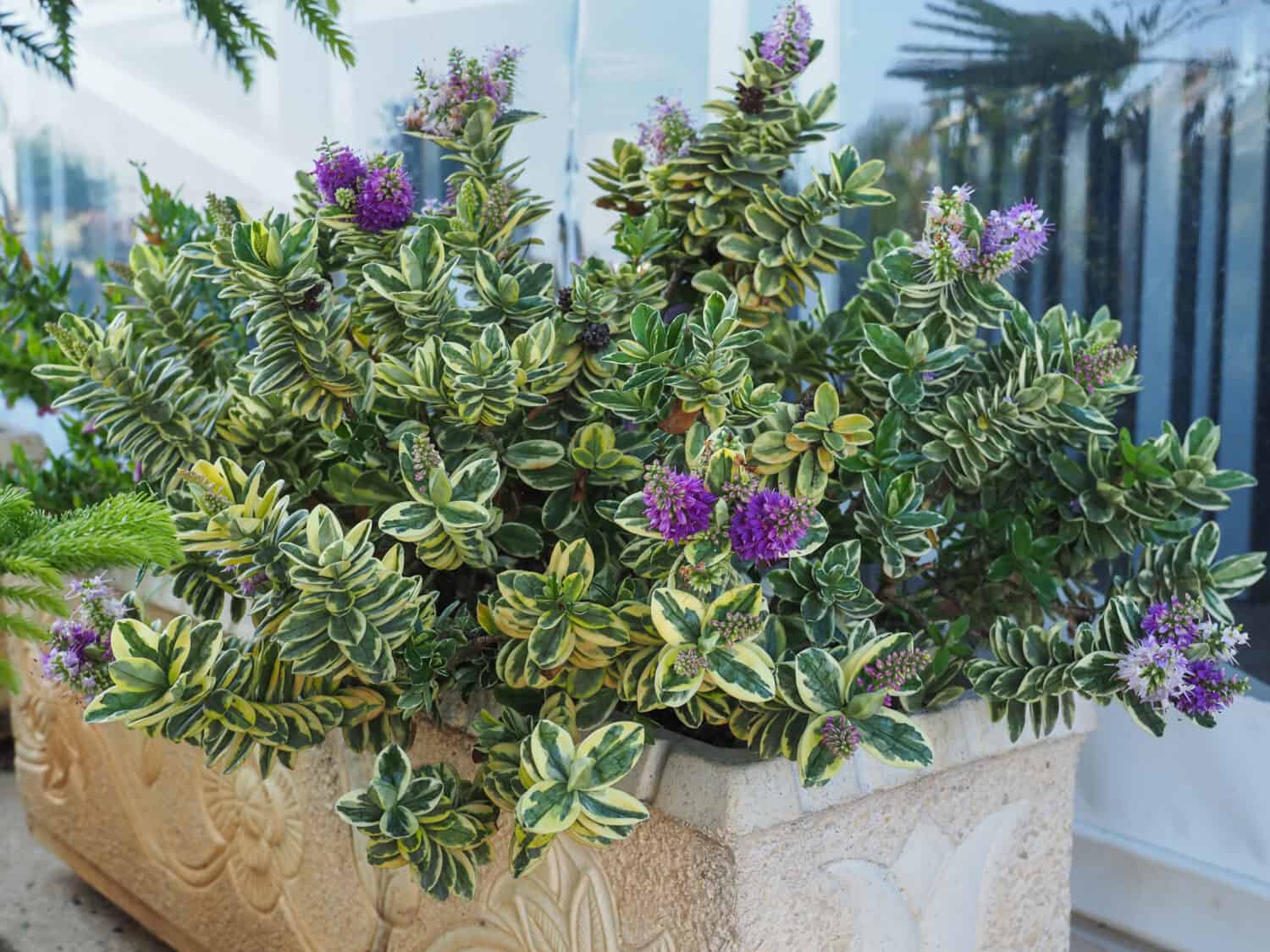
Because hebes live for the sun, place your container in open spots.
©LifeCollectionPhotography/Shutterstock.com
4. Choisya
Otherwise known as Mexican orange blossom, the vibrant Choisya shrub prospers in ceramic or terracotta pots all year round. Cultivars vary in size, though a mature plant can grow up to 120-240 cm high, requiring a larger container like a half barrel with many drainage holes at the base.
Conveniently, Choisya isn’t picky. Because it can endure neglect, you don’t have to prune or fertilize it regularly. But despite being fond of the sun, the plant doesn’t mind a few hours of shade. This species also dislikes extremely alkaline or acidic soil because it limits access to essential nutrients such as molybdenum and phosphorus. If you plan to grow Choisya plants year-round in pots, we recommend these three species:
Choisya ‘Lich’ Sundance
An original Choisya ternata variety, ‘Lich‘ is a striking shrub showy all year round. It boasts lime green leaves – spectacular in the sun – and pure white flowers. Since the latter is rich in nectar, insects love them. On top of that, these plants are disease and rabbit-resistant, so you shouldn’t worry too much about their survival as long as you care for them properly. Like all Choisya varieties, ‘Lich’ thrives in fertile, well-drained soil.
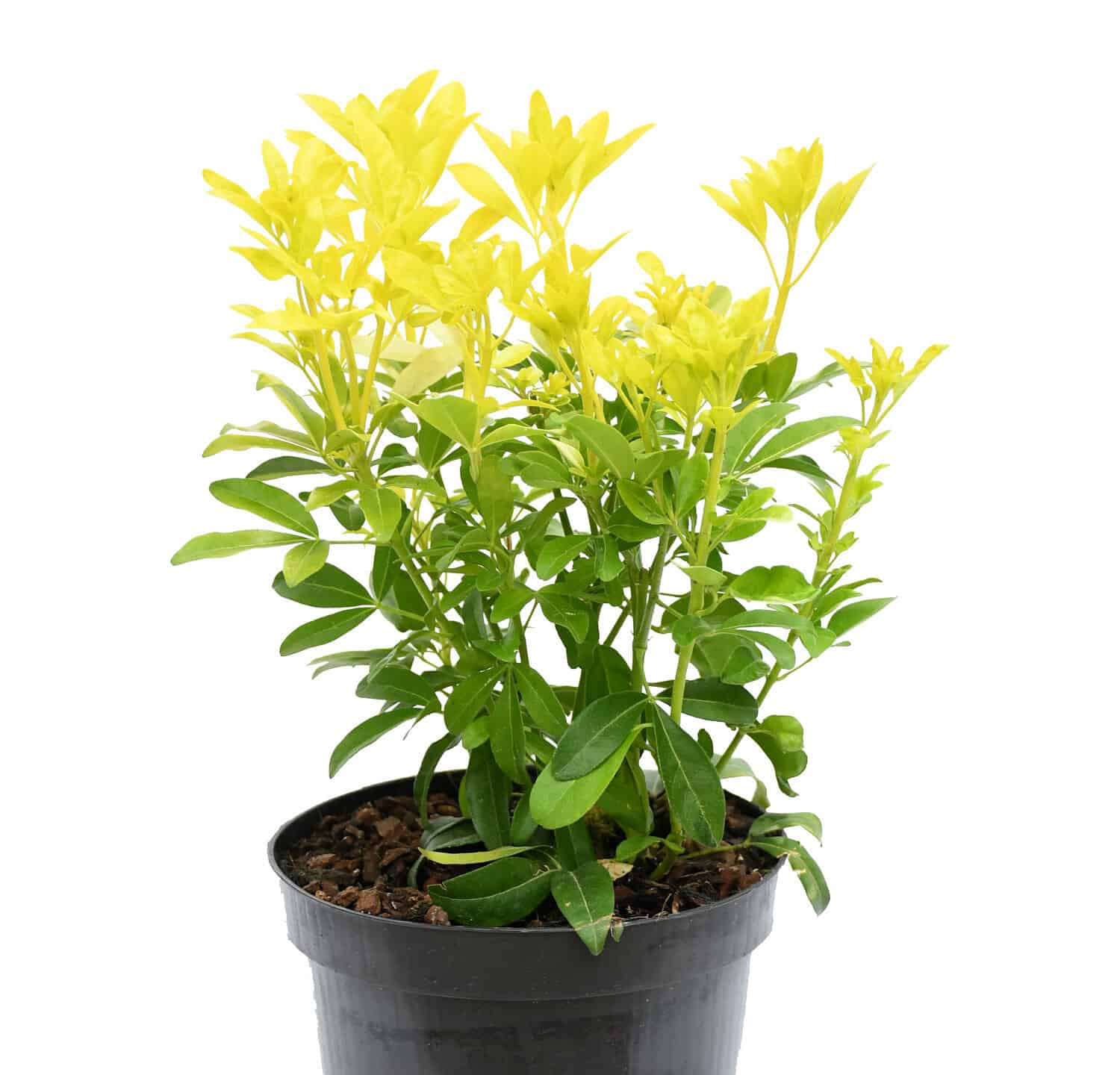
Add a splash of golden beauty to your space with a vibrant
Choisya‘Lich’ Sundance potted plant.
©praneem79/Shutterstock.com
Choisya ‘White Dazzler’
As its name suggests, this Choisya variety is stunning! In spring, you can easily spot its fragrant white blooms from a distance. Feel free to plant the species in pots in any season and keep it outdoors. But if there’s extreme heat or cold, bring it indoors to avoid draining its reserves or freezing its cells to block proper water and nutrient flow, respectively.
We don’t recommend regularly pruning the Choisya ‘White Dazzler.’ You should wait for its flowers to die off in June instead of cutting them off. However, if you grow the plant as part of a hedge, trimming it is necessary to maintain its good shape.
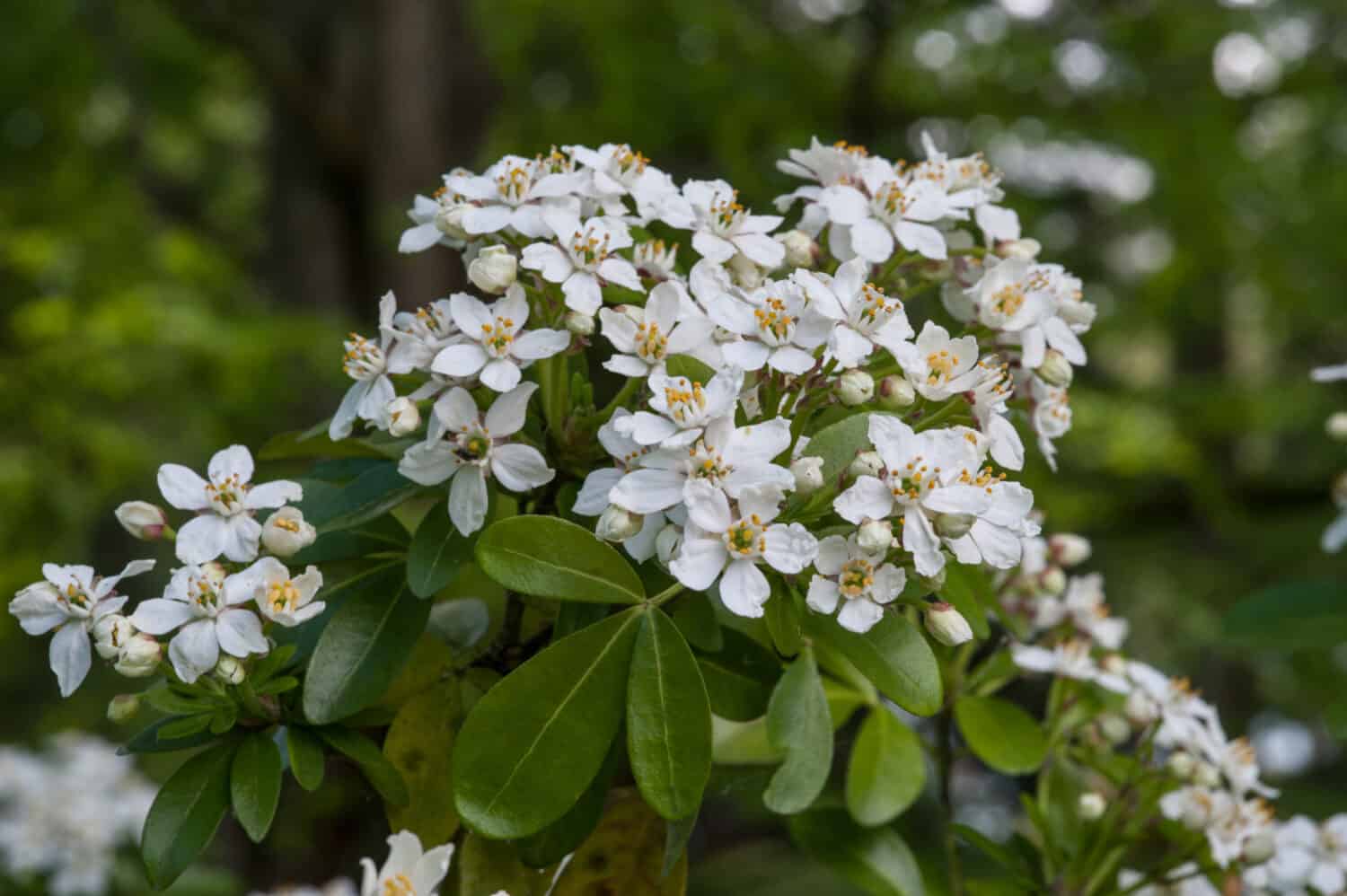
The
Choisya‘White Dazzler’ has enchanting blooms and a refreshing fragrance to elevate any space.
©B_K_Design/Shutterstock.com
Choisya ‘Aztec Gold’
Often reaching a height of 1-2 meters, the Choisya ‘Aztec Gold’ is native to Mexico. Even so, with excellent care and the right conditions, it flourishes in many other parts of the world, including the U.K. and the U.S. Frequently water this Choisya variety throughout the first season after planting it.
The Choisya ‘Aztec Gold’ flowers twice a year — from April to May and August to September. The plant’s white flowers come in a corymb shape, and its palmate leaves boast a golden shade that turns yellow in autumn.
5. Herbs
Did you know the Chinese studied herbs as far back as 2500 B.C.? You can grow these useful plants throughout the year, indoors or outdoors. Some, like cilantro, mature in only three weeks, so you don’t have to wait ages to see the fruits of your gardening endeavors.
Learning the difference between annuals and perennials should be the first thing to do when investing in herbs for year-round pots. Annuals stick around for only one growing season, allowing you to enjoy them during the summer before the cold weather lays them to waste. Examples include chervil, basil, dill, summer savory, and coriander.
On the contrary, perennials are tough species that live for a few years, braving the harshest conditions as seasons pass by. This aspect alone makes them great picks for year-round pots. Of course, you still need to find out a specific plant’s winter hardiness before considering it. Nevertheless, your top options should include chives, chicory, lemon grass, mint, oregano, sorrel, tarragon, feverfew, fennel, lemon balm, and winter savory.
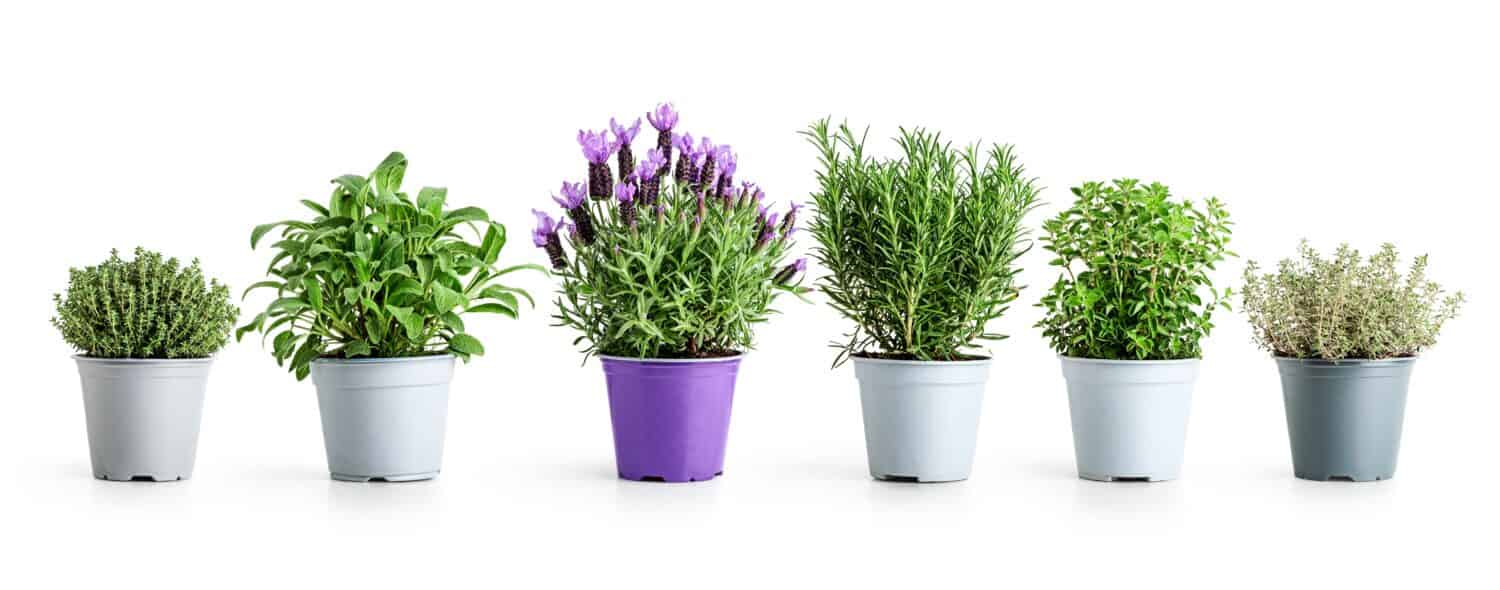
Rosemary, oregano, lavender, sage, and thyme are excellent herb alternatives to grow at home
©ifiStudio/Shutterstock.com
Choosing Containers for Growing Herbs
If you’re a novice herb gardener, you’re probably wondering how to grow the species in pots and get it right the first time. Choosing the right container to accommodate your plants is one of the most important steps. Also, ensure its base has enough holes to drain excess water and provide enough air for root uptake.
Then, you should also evaluate the pot’s features, such as their sizes, styles, shades, and materials, to ensure they fit your needs. For example, plastic containers are ideal for growers with tight budgets because they’re inexpensive, unlike ceramic stone options.
But remember that each type of pot has pros and cons, which you must be ready to deal with before making your purchase decision. For example, although plastic containers are affordable, they lack durability; you’ll need to replace them every few years, costing you more money in the long run.
6. Heuchera
Popular for being loyal dappled shade lovers, heucheras, or coral bells, are often played down. However, you have many reasons to grow and watch them add color to your garden all year. They are drought-resistant, saving you the hassle of watering them daily. In addition, these perennials don’t mind small spaces, allowing you to plant them in compact containers with 10 to 12-inch diameters.
The deer-resistant heucheras thrive in well-drained soil with loam-based compost. We propose adding a thick gravel layer around them to prevent vine weevils from laying their eggs. The insects’ larvae are arguably Heuchera‘s biggest threats as they ruthlessly munch their roots, causing wilting and even death.
Ready to plant Heuchera in year-round pots? Pick one or more of these varieties:
Heuchera ‘Caramel’
The Heuchera ‘Caramel’ boasts unique rounded, lobed foliage and is among the most gorgeous coral bell cultivars. The plant’s leaves are grey-red in the spring. But in the summer, they develop a stunning apricot-caramel shade with burgundy-red undersides. We suggest eliminating faded flower stems as soon as you notice them to encourage further blooming.
Heuchera ‘Amber Waves’
One of the most distinct aspects of this Heuchera cultivar is its beautiful deeply-lobed amber leaves that turn tawny-khaki in the summer. These species prefer partial shade and well-drained soil. Like many other Heuchera varieties, they don’t interest deer, but they draw butterflies.
Other Heuchera varieties to discover include:
- Heuchera ‘Sashay’
- Heuchera ‘Can Can’
- Heuchera ‘Electra’
- Heuchera ‘Berry Smoothie’
- Heuchera villosa.
- Heuchera ‘Venus’
- Heuchera ‘Champagne’
- Heuchera ‘Berry Timeless’
- Heuchera ‘Lime Marmalade’
- Heuchera ‘Melting Fire’.
- Heuchera ‘Midnight Rose’
Growing the Best Plants for Year-Round Containers
These species should be among your top options for year-round pots. Although the plants boast varying features, including growth curves, sizes, flower shapes, and colors, they can easily survive in containers for a year or longer. But before you plant any of them, research other growers’ experiences to know what to expect and grasp everything it’ll take to provide proper care.
Whatever the species you choose, give them your all so your gardening journey yields the desired results. After all, the goal should be to add life to your garden and enjoy all the benefits of the plants you grow. For instance, a well-maintained bonsai tree beautifies your space. Because it can also cost a fortune, it might be your ticket to financial freedom.
Then again, don’t forget some of these plants are toxic to babies and pets. A good example is ‘Paula,’ a hebe variety that poisons cats and dogs, causing tummy aches and a burning mouth. If you discover the species you’re growing in your garden can harm your loved ones, keep them out of the area for their safety.
The photo featured at the top of this post is © Reda.G/Shutterstock.com
Thank you for reading! Have some feedback for us? Contact the AZ Animals editorial team.






